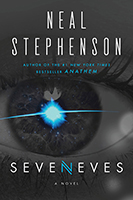 At first, I thought the titular Seveneves referred to fragments of the Moon. It blows up on the first page of the novel – or disaggregates anyhow, into seven big chunks. But these start knocking into one another, breaking off smaller pieces, and these bang into each other, making more pieces.
At first, I thought the titular Seveneves referred to fragments of the Moon. It blows up on the first page of the novel – or disaggregates anyhow, into seven big chunks. But these start knocking into one another, breaking off smaller pieces, and these bang into each other, making more pieces.
Soon, there are a lot of pieces.
Spoilers galore follow, as I feel obligated to outline the scope of the story: The mathematics of making a lot of pieces from the seven originals is a scientific problem that catches the interest one of the main characters, a PR-savvy astronomer who’s clearly modeled on Neil DeGrasse Tyson. He runs the numbers and finds that the system of moon fragments’ auto-catalyzing fragmentation will go exponential about two years after the moon broke up. This isn’t good news for the surface of Earth. Humanity has two years to get a space colony going, and stock it with enough genetic information to kick-start human civilization some thousands of years in the future after the “Hard Rain” ceases and the surface of the planet becomes habitable again.
The politics and the logistics of who to save kick in, and basically everyone pitches in, trying to make this project a success, since the future of the human race and life on Earth hinges on it. The novel is set in the here and now, and Facebook and Twitter figure into the plot. By the time the Hard Rain begins to fall and >7 billion people (and every other form of life) on the surface are killed, about a thousand folks are in orbit in a hastily-constructed “Cloud Ark,” centered on the former International Space Station. One of them is a stowaway – the conniving President of the United States, a woman who instantly starts sowing discord in the rank and file. There’s a daring mission (by an Elon Musk like character) to bring a comet into the Ark for fuel, and various other instances of serious problem solving. Each of these challenges is addressed frankly and in detail, with plenty of exploration of perigee and apogee, ΔV and the physics of living in zero gravity amid near constant bombardment by cosmic radiation. The first two-thirds of the book has a lot of discussion of orbital mechanics. You should know that going in, and you should also know that it’s not boring. While the technical problems can be solved to greater or lesser degrees, the human problem (of how to get along) is presented as a constant. People make moves, other people respond, and there are deaths. Soon, there are waaaaaaaaaaaaaay fewer people left than is in any way acceptable, but one of them is a geneticist, and her lab equipment survives, and after a brief discourse on parthenogenesis and heterozygosity, we see her plan for furthering the human species – essentially, one of each of the surviving women is author of a ‘race’ of future humans.
Fast forward 5,000 years. The final third of the book examines the results, specifically the return to Earth mid-way through the terraforming effort put into effect by the descendants of the Seven Eves. Once there, they find to their surprise that they aren’t alone. As the various strands of humanity become reacquainted, there is some static, and again some awful behavior, as well as some positive connections and unexpected outcomes. I’ll avoid going into too much. That part of the book feels like a typical science fiction novel, so the plot is perhaps more important than the set-up.
But what sticks with me about the book is the set-up – the first two thirds of the book that posit this extraordinary circumstance, and examine how we would deal with it. If we knew the planet would be totally lethal in two years, and would remain uninhabitable for five millennia, how would we act? What would we do? This, to me, is the most interesting thing about Seveneves – its examination of the real-world fallout from that initial extraordinary premise.
I enjoyed the book. I don’t read much science fiction, but this held my attention, and I’ll seek out more from the author, Neal Stephenson. It would make a great movie.
Here’s a review from NPR that speaks to my experience reading it – in particular, the balance Stephenson seems to get just right about explaining things completely but without letting your attention span down.
I found out about the book from the Don’t Panic Geocast, which reviewed it alongside The Martian. I’d say The Martian was the better book, but it’s kind of comparing apples and really complicated oranges to say that. They are both worth reading.

Neal Stephenson has written some terrific novels. I’m looking forward to reading this one. The Baroque Cycle is highly recommended, a great swash -buckling read with some brilliant science and history mixed in.